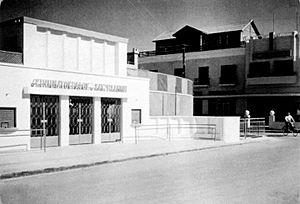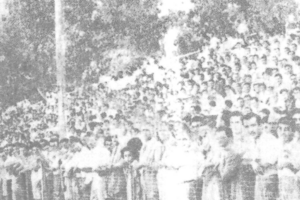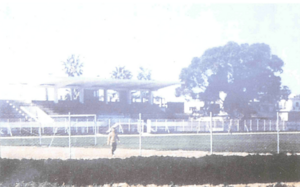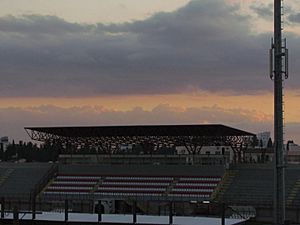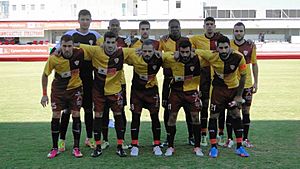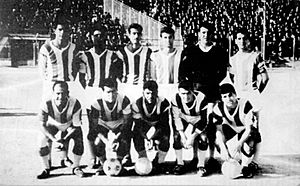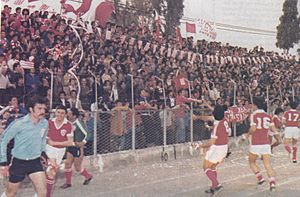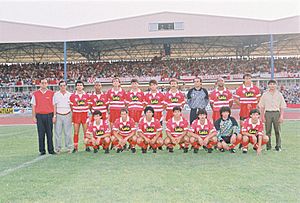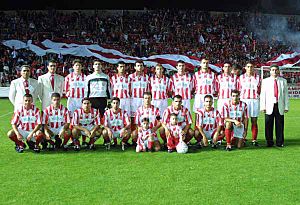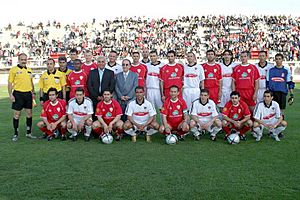Nea Salamis Famagusta FC facts for kids
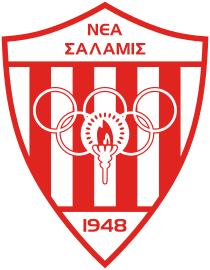 |
|||
| Full name | Nea Salamis Famagusta FC Greek: Νέα Σαλαμίνα Αμμοχώστου |
||
|---|---|---|---|
| Nickname(s) | Ερυθρόλευκοι (Red and Whites) | ||
| Founded | 7 March 1948 | ||
| Ground | Ammochostos Stadium, Cyprus | ||
| Capacity | 5,750 | ||
| Owner | Elefthyrios Constantinou | ||
| Chairman | George Constantinou | ||
| Manager | Christodoulos Christodoulou | ||
| League | First Division | ||
| 2021–22 | Second Division, 2nd (promoted) | ||
|
|
|||
Nea Salamis Famagusta FC (also called Nea Salamina) is a professional football club from Ammochostos (also known as Famagusta) in Cyprus. Since 1974, the club has been a "refugee club" because of the Turkish invasion of Cyprus, which led to Turkey occupying the northern part of the island. The club is currently based in Larnaca.
Nea Salamina's biggest wins were in 1990, when they won the Cypriot Cup and the Cypriot Super Cup. The team's best finish in the top Cypriot league, the Cypriot First Division, was third place. For its first five years (1948–1953), the team played in the Cyprus Amateur Football Federation championships. In 1953, the club joined the main Cyprus Football Association (CFA) and has played in its championships and cup competitions ever since. Nea Salamina has played in the Cypriot First Division for over 50 seasons.
The team first played in a European competition in 1990 in the UEFA Cup Winners' Cup. They also played in the UEFA Intertoto Cup in 1995, 1997, and 2000. The football team is part of the larger Nea Salamina Famagusta sports club, which started in 1948. This club also has a men's volleyball team. The club is named after an ancient city in Cyprus, Salamis or Salamina, which is close to modern Famagusta. "Nea" means "new" in Greek.
Contents
Club Beginnings
In the late 1940s, when Nea Salamina Famagusta was founded, there was a lot of political tension in Greece, which also affected Cyprus. Many athletes were involved in politics. In Famagusta, there were two main sports clubs: GSE and Anorthosis Famagusta F.C.. These clubs started to limit athletes who had left-wing political views. Anorthosis even hosted a right-wing political party at its clubhouse.
Because of these restrictions, a group of people in Famagusta decided in early 1947 that the city needed a new sports club. They wanted a club where everyone could join, no matter their political beliefs. So, on March 7, 1948, the Nea Salamina sports club was officially formed. It was the first sports club in Cyprus that welcomed everyone, including those with left-wing views. Many people wanted to join the new club.
Stadium Challenges and New Leagues
Before the Pancyprian Games in May 1948, a sports organization asked all Cypriot sports clubs to sign a statement supporting right-wing groups in the Greek Civil War. Most clubs signed, but some, like Kinyras Paphos and the left-wing athletes, refused. Because of this, two athletes from GSE, Antonis Totsis and Nikis Georgiou, were asked to apologize, but they insisted that sports should be separate from politics.
As a result, Nea Salamina was not allowed to use the GSE Stadium. This was a big problem because they had nowhere to play. Similar issues happened in other cities. In Larnaca, the Alki Larnaca F.C. was founded but was banned from using the GSZ Stadium. In Nicosia, some players left APOEL F.C. to form AC Omonia because of political disagreements.
Because these new clubs were not accepted by the main Cyprus Football Association (CFA), they created their own football group called the Cyprus Amateur Football Federation (CAFF) in December 1948. This new federation organized its own leagues and cups, which became very popular. Six teams were part of CAFF, including Nea Salamina.
Uniting Cypriot Football
The teams in CAFF wanted to unite Cypriot football. They tried for three years to join the CFA. Having two separate football groups in a small country like Cyprus caused problems and slowed down the sport's growth. Everyone felt that sports should bring people together, not divide them.
In 1953, Nea Salamina, Omonia, Alki, and Antaeus applied to join the CFA. On September 19, the CFA accepted Nea Salamina and Omonia. However, the CFA still had some strict rules. They only allowed one team to join the top league (Cypriot First Division) and two teams to join the second league (Cypriot Second Division). To make unification happen, the CAFF clubs agreed. Omonia joined the first division, while Nea Salamina and Antaeus joined the second division. After these decisions, CAFF was no longer needed.
The first friendly game between teams from the two former federations was played by Nea Salamina and Anorthosis at GSE Stadium on September 27, 1953. About 5,200 fans watched the game. Anorthosis won 3–1, and the match showed great sportsmanship between the fans.
Home Stadiums
After being banned from the GSE stadium, Nea Salamina had no place to train. They started practicing at a local pitch in Famagusta and worked to build their own stadium. In December 1948, Israel donated money to Famagusta as thanks for help given to Jewish refugees. A city council member and Nea Salamina player, Gabriel Makris, suggested using this money to build a municipal stadium for everyone.
Construction of the municipal stadium began in early 1949 with volunteers, including club supporters and players. It was finished in 1952 and was the first stadium in Cyprus with a roof over the stands. It served as Nea Salamina's main base from 1952 to 1953.
After football united in 1953, Nea Salamina used GSE Stadium for games and the Municipal Stadium for training. This continued until 1974, when Famagusta was occupied by the Turkish Army. The club was forced to leave its home.
Ammochostos Stadium
From 1974 to 1991, Nea Salamina played at different stadiums, including GSZ Stadium in Larnaca, Dasaki Stadium in Dasaki Achnas, and Antonis Papadopoulos Stadium in Larnaca. In 1991, the team built its own stadium, Ammochostos Stadium.
Ammochostos Stadium is owned by Nea Salamina and is located in Larnaca. It has 5,000 seats and is mainly used for football. The club's offices are also there. The stadium is named after Famagusta (Ammochostos in Greek), the club's original home before the Turkish occupation. It was built in 1991 near refugee camps. The stadium was completed on time thanks to supporters in Cyprus and abroad, the Cyprus Sports Organisation, and many volunteers.
The first game Nea Salamina Famagusta played in their new stadium was on October 12, 1991, against Evagoras Paphos. Nea Salamina won 4–1. The stadium also hosted the final of the 1992 UEFA European Under-16 Championship on May 17, 1992, where Germany beat Spain 2–1.
Club Colors and Emblem
Nea Salamina's emblem features the Olympic flame and the five rings of the Olympic Games. When the club first started, its colors were yellow and crimson. In 1950, the club's leaders changed the colors to red and white. Red stands for power, and white stands for peace. They chose red-and-white striped jerseys because they looked like those worn by Olympiacos Piraeus, a famous Greek team.
Team Achievements
Early Years in CAFF
Nea Salamina played in the Cyprus Amateur Football Federation (CAFF) for five seasons. They didn't win a championship title during this time, but they finished second in their last two years. In the 1952–53 season, they reached the cup final but lost 2–0 to AC Omonia.
Joining the CFA: 1950s
After joining the main Cypriot football league in 1953, Nea Salamina played in the Cypriot Second Division. Their main goal was to get promoted to the top league. They finished second in their group in the 1953–54 season and reached the semi-finals of the 1953–54 Cypriot Cup.
The next season, 1954–55, the team won their group in the second division and earned promotion to the Cypriot First Division. They also had a big win in the 1954–55 Cypriot Cup, beating APOEL 3–2.
In the 1955–56 Cypriot First Division, Nea Salamina played in the top league for the first time and finished third. This is their highest finish ever, a position they have reached four times. Their first top-division game was a 3–2 victory against their rival Anorthosis. In their early years in the first division, they often beat strong teams like APOEL FC and AC Omonia.
The 1960s: Strong Performances
In the early 1960s, Nea Salamina was very strong at home games but struggled when playing away. The club's youth team also won an amateur championship in 1960–61, which was celebrated by fans.
The 1965–66 Cypriot First Division season was one of Nea Salamina's best. They played excellent football and were close to winning the championship. They reached their first cup final but lost 4–2 to Apollon Limassol. During this period, Nea Salamina had one of the best defenses in the league.
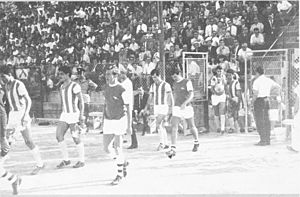
The 1970s: Becoming a Refugee Club

The biggest challenge for the club came on August 14, 1974, when Famagusta was occupied by Turkish troops. Nea Salamina became a refugee club, and its players and fans were scattered. In October, the club's leaders met and decided to keep the club going. Since most players were in Larnaca, they made it the club's temporary home.
The club participated in a special championship in late 1974 to stay in the Cypriot First Division. They played at various stadiums because they didn't have a permanent home. By 1979, Nea Salamina was a regular in the first division, but they were relegated to the second division at the end of the 1978–79 Cypriot First Division season.
The 1980s: Return to Success
In the 1979–80 season, Nea Salamina played in the second division. Many fans came to their games, sometimes even more than for first-division matches. The team easily won the league and returned to the top division for the 1980–81 Cypriot First Division season. They even beat the future champions Omonia 2–1 in their first game back.
In the 1982–83 Cypriot First Division season, there was a notable incident where three Nea Salamina players were sent off in a game. This led to a dispute with the linesman and the players faced severe penalties, including being suspended from playing for several months.
The team continued to play at different stadiums until 1991 when their new Ammochostos Stadium was built. In the 1988–89 season, they finished fourth in the league and almost reached the cup final.
The 1990s: Winning Trophies
The 1989–90 season was the most successful in Nea Salamina's history. They won their first major title, the 1989–90 Cypriot Cup. Many fans traveled to Cyprus to watch the final. On June 8, 1990, Nea Salamina defeated Omonia 3–2 at Tsirion Stadium in Limassol.
Just a few months later, Salamina won its second title, the LTV Super Cup Shield, by beating APOEL 1–0.
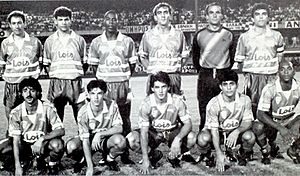
As cup winners, Nea Salamina played in a European competition for the first time in the 1990–91 European Cup Winners' Cup. They were eliminated by a strong team, Aberdeen F.C., from Scotland.
The 1990s were a great time for Nea Salamina. Besides winning the cup and shield, they also built their own stadium. In the 1992–93 Cypriot First Division season, they finished third in the league. They were also the first Cypriot team to play in the UEFA Intertoto Cup in 1995.
The 2000s: Ups and Downs
In the early 2000s, Nea Salamina was relegated to the second division four times. In the 1999–2000 Cypriot First Division season, they finished fourth and earned a spot in the 2000 UEFA Intertoto Cup. However, in the 2000–01 Cypriot First Division season, they finished twelfth and were relegated. Despite this, they reached the 2000–01 Cypriot Cup final, losing 1–0 to Apollo. They were the first Cypriot team to play in a cup final while being relegated.
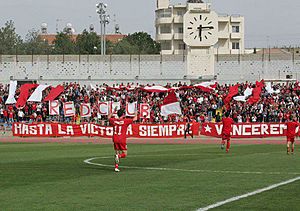
Nea Salamina became second-division champions in 2001–02, earning promotion back to the first division. They were relegated again in the 2002–03 Cypriot First Division season but won the second division championship again the following year and were promoted. They finished sixth in the 2004–05 Cypriot First Division and 2005–06 Cypriot First Division seasons. After being relegated again in 2007–08, they returned to the first division in 2008–09 Cypriot Second Division after a tough season.
Since 2010
Nea Salamina was relegated to the second division again in the 2009–10 Cypriot First Division season but was promoted back to the first division the next year. In the 2011–12 Cypriot First Division season, they finished seventh. In the 2012–13 Cypriot First Division season, they finished eleventh and had to play a special playoff game against Anagennisi Deryneia to stay in the top league. Nea Salamina won 3–0 and kept their spot in the 2013–14 Cypriot First Division. They finished seventh again in the 2013–14 Cypriot First Division season.
European Competitions
Nea Salamina first played in a European cup in 1990, where they were defeated by Aberdeen F.C.. They also played in the UEFA Intertoto Cup in 1995 and 1997. In the 2000 UEFA Intertoto Cup, they won two games against KS Vllaznia Shkodër from Albania, but then lost to Austria Wien from Vienna.
| Season | Cup | Round | Club | Home | Away | |
|---|---|---|---|---|---|---|
| 1990–91 | Cup Winners' Cup | First round | 0–2 | 0–3 | ||
| 1995 | Intertoto Cup | Group stage | --- | 1–2 | 3rd |
|
| 2–0 | --- | |||||
| --- | 1–1 | |||||
| 0–2 | --- | |||||
| 1997 | Intertoto Cup | Group stage | --- | 1–4 | 4th |
|
| 4–1 | --- | |||||
| --- | 0–4 | |||||
| 1–10 | --- | |||||
| 2000 | Intertoto Cup | First round | 4–1 | 2–1 | ||
| Second round | 1–0 | 0–3 |
Current Players
|
|
Players on Loan
|
Club Managers
 Michael Daniel Sialic (1948–49)
Michael Daniel Sialic (1948–49) Ruben Perperian (1949)
Ruben Perperian (1949) Gkilli (1950)
Gkilli (1950) Kostakis Antoniades (1950–51)
Kostakis Antoniades (1950–51) Kostas Eleftheriou (1951)
Kostas Eleftheriou (1951) Henderson (1952)
Henderson (1952) Kostakis Antoniades (1952–53)
Kostakis Antoniades (1952–53) Costas Vasileiou (1953–55)
Costas Vasileiou (1953–55) Kostas Tsiges (1955–57)
Kostas Tsiges (1955–57) Gyula Zsengellér (1957–59)
Gyula Zsengellér (1957–59) Nikis Georgiou (1959–61)
Nikis Georgiou (1959–61) Costas Vasileiou (1961–62)
Costas Vasileiou (1961–62) Nikis Georgiou (1962–64)
Nikis Georgiou (1962–64) Costas Vasileiou (1964–65)
Costas Vasileiou (1964–65) Kostakis Antoniades (1965–67)
Kostakis Antoniades (1965–67) Stoyan Petrov (1967–68)
Stoyan Petrov (1967–68) Andreas Fokkis (1968–69)
Andreas Fokkis (1968–69) Pambos Avraamides (1969–71)
Pambos Avraamides (1969–71) Sima Milovanov (1971–73)
Sima Milovanov (1971–73) Maurikios Aspros (1973–74)
Maurikios Aspros (1973–74) Maurikios Aspros (1974–75) (Limassol)
Maurikios Aspros (1974–75) (Limassol) Andreas Konteatis/
Andreas Konteatis/ Nikis Georgiou (1974–75) (Larnaca)
Nikis Georgiou (1974–75) (Larnaca) Kostakis Antoniades (1975–77)
Kostakis Antoniades (1975–77) Spiro Debarski (1977–80)
Spiro Debarski (1977–80) Jozef Jankech (1980–82)
Jozef Jankech (1980–82) Andreas Mouskallis (1983)
Andreas Mouskallis (1983) Mario Buzek (1983–84)
Mario Buzek (1983–84) Milan Máčala (1984–86)
Milan Máčala (1984–86) Andreas Mouskallis (1986–90)
Andreas Mouskallis (1986–90) Bozhil Kolev (1990–91)
Bozhil Kolev (1990–91) Jerzy Engel (1991–94)
Jerzy Engel (1991–94) Momčilo Vukotić (1994-17 May 1995)
Momčilo Vukotić (1994-17 May 1995) Boris Nikolov (1 June 1995 – 12 December 1995)
Boris Nikolov (1 June 1995 – 12 December 1995) Jerzy Engel (28 December 1995 – 17 May 1996)
Jerzy Engel (28 December 1995 – 17 May 1996) Slobodan Karalić (14 May 1996 – 6 January 1998)
Slobodan Karalić (14 May 1996 – 6 January 1998) Lucas Kotrofos (6 January 1998 – 16 March 1998)
Lucas Kotrofos (6 January 1998 – 16 March 1998) Michael Urukalo (16 March 1998 – 10 May 1998)
Michael Urukalo (16 March 1998 – 10 May 1998) Andreas Mouskallis (13 May 1998 – 1 May 1999)
Andreas Mouskallis (13 May 1998 – 1 May 1999) Slobodan Vučeković (13 May 1999 – 26 February 2001)
Slobodan Vučeković (13 May 1999 – 26 February 2001) Zlatko Krmpotić (27 February 2001 – 18 March 2001)
Zlatko Krmpotić (27 February 2001 – 18 March 2001) Andreas Kissonergis (19 March 2001 – 31 May 2001)
Andreas Kissonergis (19 March 2001 – 31 May 2001) Takis Antoniou (10 June 2001 – 7 January 2003)
Takis Antoniou (10 June 2001 – 7 January 2003) Georgi Vasilev (11 January 2003 – 14 March 2003)
Georgi Vasilev (11 January 2003 – 14 March 2003) Panicos Orphanides (16 March 2003 – 6 April 2005)
Panicos Orphanides (16 March 2003 – 6 April 2005) Imre Gellei (10 June 2005 – 24 October 2005)
Imre Gellei (10 June 2005 – 24 October 2005) Andreas Michaelides (24 October 2005 – 5 November 2006)
Andreas Michaelides (24 October 2005 – 5 November 2006) Nikos Andronikou (7 November 2006 – 4 May 2007)
Nikos Andronikou (7 November 2006 – 4 May 2007) Georgios Kostikos (7 May 2007 – 28 October 2007)
Georgios Kostikos (7 May 2007 – 28 October 2007) Panicos Orphanides (7 November 2007 – 5 November 2008)
Panicos Orphanides (7 November 2007 – 5 November 2008) Savvas Constantinou (17 November 2008 – 31 December 2008)
Savvas Constantinou (17 November 2008 – 31 December 2008) Michael Hadjipieris (5 January 2009 – 20 April 2009)
Michael Hadjipieris (5 January 2009 – 20 April 2009) Attila Supka (21 April 2009 – 1 November 2009)
Attila Supka (21 April 2009 – 1 November 2009) Mirko Mihić (3 November 2009 – 22 December 2009)
Mirko Mihić (3 November 2009 – 22 December 2009) Nir Klinger (30 December 2009 – April 2010)
Nir Klinger (30 December 2009 – April 2010) Nedim Tutić (21 April 2010 – 17 October 2010)
Nedim Tutić (21 April 2010 – 17 October 2010) Stephen Constantine (18 October 2010 – 31 May 2012)
Stephen Constantine (18 October 2010 – 31 May 2012) Nicos Andreou (28 June 2012 – 18 November 2012)
Nicos Andreou (28 June 2012 – 18 November 2012) Mirsad Jonuz (21 November 2012 – 31 May 2013)
Mirsad Jonuz (21 November 2012 – 31 May 2013) Apostolos Charalampidis (19 June 2013 – 7 September 2013)
Apostolos Charalampidis (19 June 2013 – 7 September 2013) Dimitris Kalaitzidis (11 September 2013 – 15 January 2014)
Dimitris Kalaitzidis (11 September 2013 – 15 January 2014) Neophytos Larkou (16 January 2014 – 16 December 2014)
Neophytos Larkou (16 January 2014 – 16 December 2014) Nicos Panayiotou (16 December 2014 – 4 May 2015)
Nicos Panayiotou (16 December 2014 – 4 May 2015) Floros Nicolaou (5 May 2015 – 6 June 2015) Caretaker
Floros Nicolaou (5 May 2015 – 6 June 2015) Caretaker Jan de Jonge (19 June 2015 – 22 April 2016)
Jan de Jonge (19 June 2015 – 22 April 2016) Eugen Neagoe (7 May 2016 – 19 September 2016)
Eugen Neagoe (7 May 2016 – 19 September 2016) Staikos Vergetis (20 September 2016 – 6 March 2017)
Staikos Vergetis (20 September 2016 – 6 March 2017) António Conceição (16 March 2017 – 23 May 2017)
António Conceição (16 March 2017 – 23 May 2017) Liasos Louka (6 June 2017 – 17 October 2017)
Liasos Louka (6 June 2017 – 17 October 2017) Savvas Poursaitidis (18 October 2017 – 22 May 2020)
Savvas Poursaitidis (18 October 2017 – 22 May 2020) Pambos Christodoulou (4 June 2020 – 30 October 2020)
Pambos Christodoulou (4 June 2020 – 30 October 2020) Savvas Damianou (30 October 2020 – 14 March 2021)
Savvas Damianou (30 October 2020 – 14 March 2021) Chrysis Michael (15 March 2021 – 20 April 2021)
Chrysis Michael (15 March 2021 – 20 April 2021) Constantinos Mina (20 April 2021 – 6 July 2021)
Constantinos Mina (20 April 2021 – 6 July 2021) Nikodimos Papavasiliou (9 July 2021 – 27 January 2022)
Nikodimos Papavasiliou (9 July 2021 – 27 January 2022) Savvas Poursaitidis (27 January 2022 – )
Savvas Poursaitidis (27 January 2022 – )
Relations with Turkish Cypriots
From the very beginning, Nea Salamina wanted to build good relationships with Turkish Cypriots in Famagusta. Turkish Cypriot players even played for the club in the early 1950s. When the team joined the CFA, they played against Turkish teams.
When Turkish Cypriot clubs started leaving CFA tournaments in late 1955, Nea Salamina tried to convince them to stay. Turkish players were always welcome at Nea Salamina. In 2004, two Turkish Cypriot footballers, Imam and Oulousoi, joined Nea Salamina. They were the first Turkish Cypriot players in the CFA in thirty years.
On March 26, 2005, Nea Salamina played a friendly game against the Turkish Cypriot team Yenicami at Ammochostos Stadium. Nea Salamina won 6–0. This was a very special event because it was the first match between Greek and Turkish Cypriot clubs in 50 years. About 2,500 fans sat together, and important leaders and sports officials attended the game.
Women's Football Team
In 2006, Nea Salamina started a women's football team. In their first season (2006–07) in the Cypriot First Division, the team finished third. They also reached the Cypriot Women's Cup final, where they lost 3–1 to AEK Kokkinochorion. However, that same year, they won the Super Cup by beating AEK Kokkinochorion 2–1 at Ammochostos Stadium.
In the 2007–08 and 2008–09 seasons, the women's team finished second. In 2008–09, Skevi Antoniou was the top scorer in the Cypriot First Division with an amazing 64 goals! The women's team stopped playing in 2010 due to financial reasons.
Club Trophies
- Cypriot Cup
- Winners (1): 1989–90
- Cypriot Super Cup
- Winners (1): 1990
- Cypriot Second Division
- Winners (4): 1954–55, 1979–80, 2001–02, 2003–04
Images for kids
-
Nea Salamina Famagusta FC fans at Ammochostos Stadium in a game against Alki Larnaca F.C. in season 2011–12.
See also
 In Spanish: Nea Salamina Famagusta de Fútbol para niños
In Spanish: Nea Salamina Famagusta de Fútbol para niños


